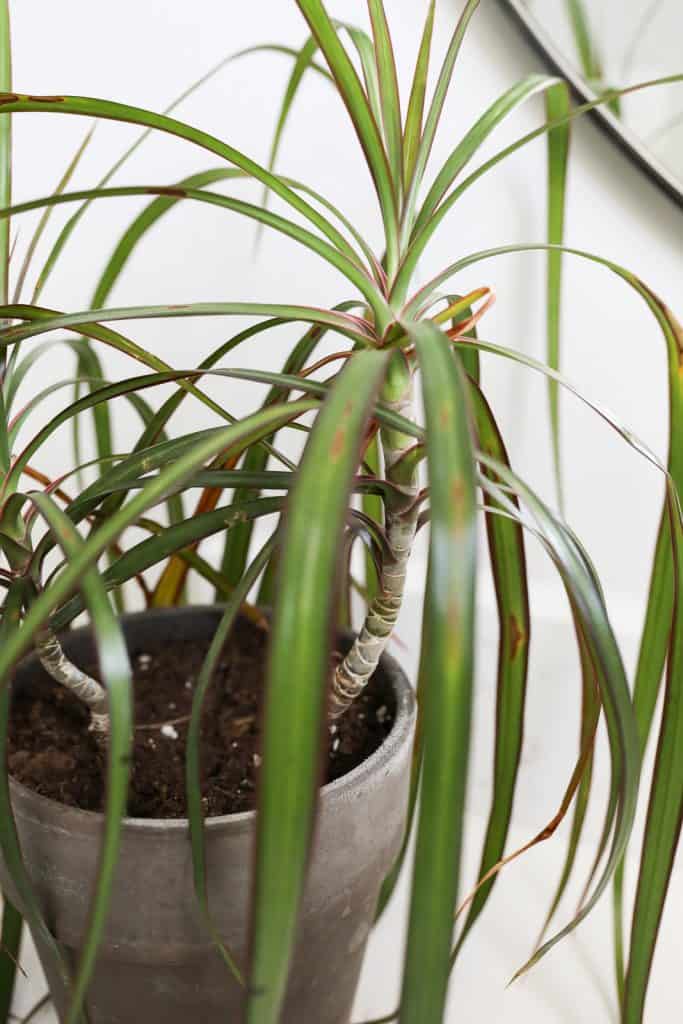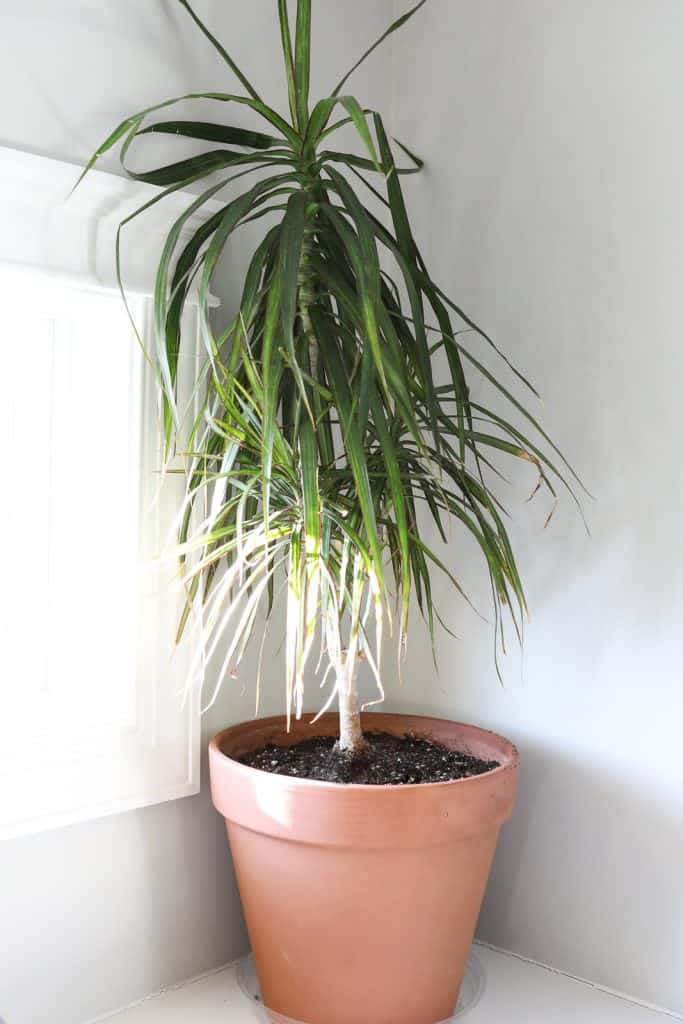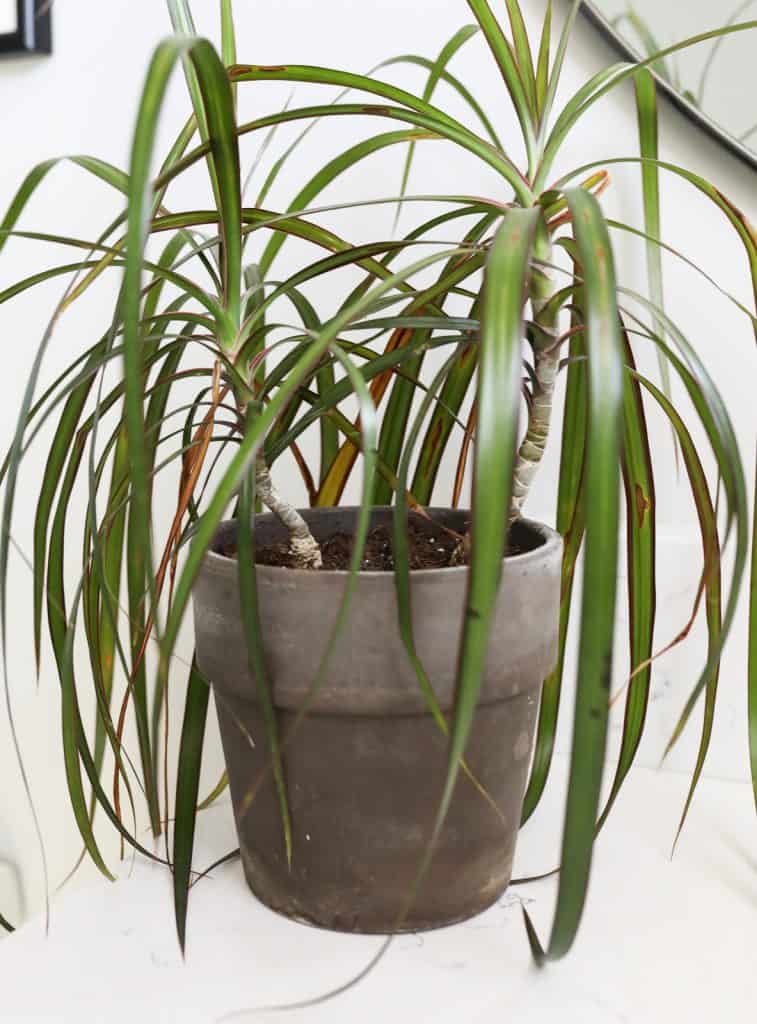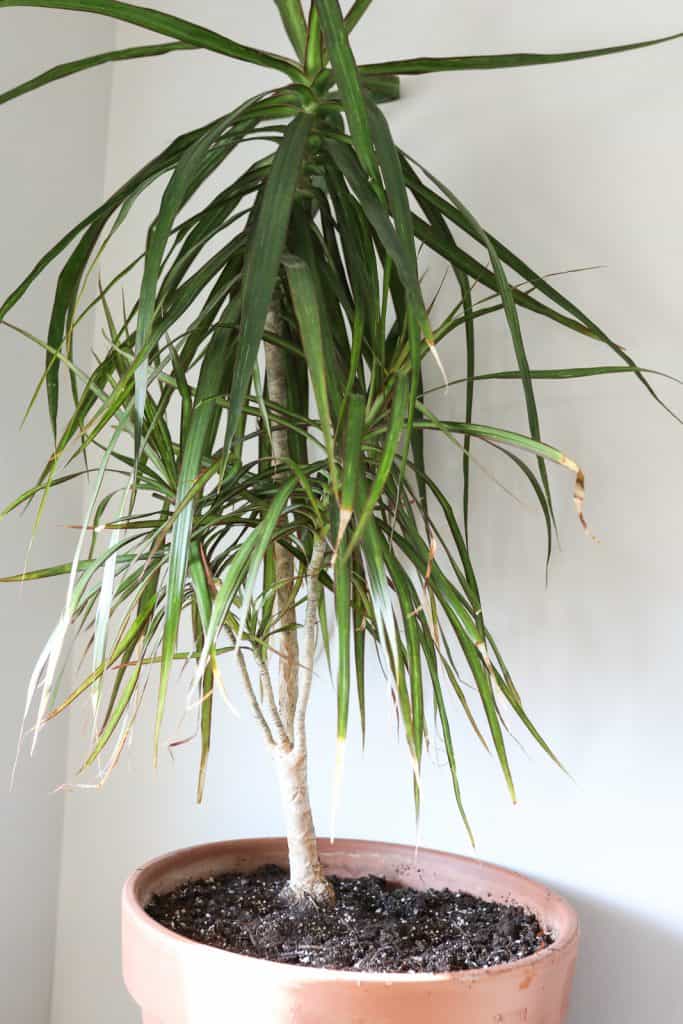Are you thinking of getting a Madagascar dragon tree, also known as Dracaena Marginata? It’s a beautiful plant that doesn’t require too much attention to thrive.
This towering indoor plant is a hit among plant collectors and interior designers all over the world for its stunning tropical beauty. It’s no surprise.
The dragon tree acts as an air purifier, clearing the house of harmful chemicals xylene and trichloroethylene. Tall and imposing, with vibrant needle-shaped green leaves laced with red along the edges, the Dracaena Marginata also looks amazing in your living room, dining area, office space, and even your bedroom.

Here’s everything you need to know about this aesthetically pleasing houseplant, which is also very easy to care for. If you’re in search of a low-maintenance plant, the dragon tree is a great option.
Table of Contents
Background And History
The gorgeous ornamental houseplant Dracaena Marginata (pronounced Dra-SEE-nuh mar-gi-NAH-ta), is native to Madagascar — home to some of the world’s most extraordinary flora and fauna.
Some experts say it also originated from Mauritius. However, Madagascar seems to have stuck as the country of origin, since this plant is also known as Madagascar dragon tree.

This tall, slender plant is known for its narrow, sword-like leaves with red edges. With strong, rigid stems, it can support itself without any poles or stakes.
Size
In the wild, Dracaena Marginata has been known to hit 70 feet tall! More realistically, a fully grown dragon tree outdoors can grow to be between 15 and 20 feet tall and 3 to 10 feet wide. Indoors, they can hit 6 feet or more, but it depends on your pot size and how you prune them.
Legend
So why is it called the dragon tree? According to Roman mythology, there was once a dragon named Ladon, who had 100 heads, each with a unique voice.
As a gift on her wedding day, Gaia gave her daughter Juno three golden apples. Ladon, the 100-headed-dragon, was tasked to guard these apples in the garden.
Hercules decided to steal the golden apples, so he slayed Ladon. When the dragon’s blood spilled, a tree sprang up. So they called it the dragon tree.
One relative of the Dracaena Marginata even “bleeds” when cut or damaged. The Dracaena Draco variety oozes with red-blood sap and resin, like a wounded creature. The Marginata variety does not produce red sap.
The Dracaena Marginata and Dracaena Draco, however, look almost identical. It is the inside that tells them apart — they don’t have the same color of resin.
How Long Does Dracaena Marginata Live?

The Dracaena Marginata can live decades if it is healthy and well cared for. As a slow grower, it’ll take up to 10 years to even reach 5 feet tall.
One tree of the Dracaena Draco variety in Tenerife is somewhere between 650 and 3,000 years old!
Varieties
The palm-tree-like, inexpensive houseplant has plenty of variations. Although there are several varieties of the dragon tree, these are the ones most commonly found at plant stores (and used as household plants).
D. Marginata
This is the classic dragon tree with thin purplish-red borders on each leaf. The central color of the leaf is a deep, vibrant green.
D. Marginata Bicolor
Each leaf of the D. Marginata has two colors: red and green stripes lining each leaf.
D. Marginata Tricolor
You can probably guess how many colors the Tricolor has in each leaf: three! The green leaf is lined with a spectacular red, emerald green, and a narrow strip of ivory yellow. It grows up to 6 feet in size.
D. Marginata Colorama
Upon first look, the Colorama variant looks pink. However, upon closer inspection, each leaf has three colors — red, green, and golden yellow. However, the red is more prominent, giving this dragon tree an overall look of pink, or reddish.
Dracaena Marginata ‘Tarzan’
This is quite similar to the original D. Marginata. They share the same color of leaves — deep green with red edges. The difference with the Tarzan variation, however, is the size of the leaves. They are thicker, wider and tougher.
The Tarzan is the more expensive out of these cultivars.
Watering

The Dracaena Marginata is a drought-tolerant plant. It can thrive amid dryness for many weeks, without showing any signs of deterioration.
To care for them properly, allow the top half of the soil to dry before watering again, which can take up to nearly a month. Use only distilled water with your dragon plant; they don’t like water with too much fluoride or salt.
Light requirements
Put your plant in light shade or partial shade. Avoid placing your dragon tree under direct or intense sunlight, as the leaves can easily burn.
The Dracaena Marginata does require some light, though, so don’t keep it in the dark. If the leaves start looking ugly, small, and droopy, move your plant to a place where it gets more indirect sunlight.
If you place it in areas with low light, sure, it can still survive — but its growth process will be glacial. The colors will also be less vivid.
Temperature And Humidity
The Dracaena Marginata’s growing seasons are summer and spring. It grows best in humidity, but the average home’s humidity and a little misting are good enough.
As a houseplant, it does best in temperatures from 65 to 80 degrees Fahrenheit. For humidity, it’s happy between the range of 60 percent and 80 percent.
These make excellent bathroom plants!
Should I Mist My Dracaena Marginata?
Your Dracaena Marginata does not require excessive misting. The low-maintenance dragon plant only demands misting once or twice a week.
Misting it in the winter months helps, as the air can go very dry. Misting is also a good way to remove the dust from the leaves.
Can It Go Outside?

The Dracaena Marginata cannot withstand the cold. So if you live in a place with a winter season, or a cold or sub-tropical climate, it’s best not to place it outside.
The dragon plant enjoys warm climates and will grow outdoors only if the temperature does not go below 63 to 65 degrees Fahrenheit.
Soil
To care for your Dracaena Marginata properly, you should use loamy soil. A loamy soil consists of clay, silt, sand, and peat.
Essentially, this pretty house plant requires rich soil packed with organic material. It also needs a well-draining soil to prevent root rot and other diseases.
Preparing The Soil
To prepare the soil for your dragon tree by yourself, combine the following, with equal parts of each:
- Fine bark chips or compost
- Peat
- Perlite or vermiculite
You’ll need to check occasionally to see if the well-draining soil is getting compacted. You’ll know it’s compacted if it is stiff or hardened and pulling away from the edge of your pot.
Type of Pot
When choosing a pot for your dragon tree, pick a pot with drainage. And make sure the pot is several inches larger than the root ball. This is important so that the root system has enough space to grow.
Does It Need To Be Repotted?
Because the dragon plant is a late bloomer with slow growth, you only need to repot it every few years. See how low-maintenance the Dracaena Marginata can be?
Fertilizer
You don’t have to fertilize your tree regularly. But if you are interested in promoting or speeding up its growth, you can fertilize it at the start of spring.
Use a liquid fertilizer, with a controlled release. And never fertilize it in the winter.
Pruning
Pruning the Dracaena Marginata is a simple task. Remove semi-dead leaves or leaves that are loosening. You may also cut back the stems (only use sharp, clean pruning shears).
Your dragon tree naturally sheds leaves that are dead, so just sweep them off the floor.
How To Propagate
Propagate Dracaena Marginata through stem cuttings. Root it in water and wait for it to grow roots in just three weeks. No need for rooting hormone.
Propagating Dracaena Marginata is best done in spring. This is the time when the plant is growing the most.
Common Pests And Diseases
It is very rare for this house plant to suffer from pests or illnesses. On the occasion that it does, it could be mealybugs, spider mites, scale or other types of aphids or bugs.
Toxicity
Dracaena Marginata is poisonous to both cats and dogs. When ingested, these animals can vomit, drool, get depressed, suffer from diarrhea, or lose appetite. In cats, their pupils can dilate. Take your pet to the veterinarian if it has eaten any dragon tree and is displaying symptoms.
Signs Of Problems
Even though dragon trees are easy to take care of, you should still pay attention for these tell-tale signs that your dragon tree needs a little help. Here are some of the symptoms if it is sick:
1. Falling Leaves
If your dragon tree is shedding leaves, it can be a sign of any of the following:
- Roots are rotting
- Sudden environmental changes
- Spider mites
2. Yellowing Leaves
If your dragon tree’s leaves are turning yellow, then it is likely from over-watering. While this specific plant will not die if you over-water it, it can still have issues when it drowns. This happens if you keep watering it even if its top-half soil has not dried yet (which takes a couple of weeks).
3. Browning Leaves
Brown leaves can be caused by the following problems:
- Excessive fluoride or salt in water
- Lack of humidity
- Severe temperature
4. Drooping Leaves
If your dragon tree’s leaves start drooping, it could be because of any of the following reasons:
- Drowning from over-watering
- Rotting roots
- Rotting stem
Final Thoughts
If you’re looking for an easy new plant that won’t take a lot of time and attention, the dragon tree fits the bill. Just learn the basics and the plant will do wonders in your house. They also make wonderful gifts because they are easy to propagate.
Want more care tips? Here’s how to care of your Dracaena Lemon Lime as well as a variety of different types of Dracaena!
Check out some other great bathroom plants that love humidity here!

